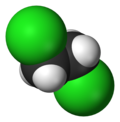This is an old revision of this page, as edited by Beetstra (talk | contribs) at 16:11, 16 February 2012 (Saving copy of the {{chembox}} taken from revid 471086269 of page 1,2-Dichloroethane for the Chem/Drugbox validation project (updated: 'ChEMBL').). The present address (URL) is a permanent link to this revision, which may differ significantly from the current revision.
Revision as of 16:11, 16 February 2012 by Beetstra (talk | contribs) (Saving copy of the {{chembox}} taken from revid 471086269 of page 1,2-Dichloroethane for the Chem/Drugbox validation project (updated: 'ChEMBL').)(diff) ← Previous revision | Latest revision (diff) | Newer revision → (diff)| This page contains a copy of the infobox ({{chembox}}) taken from revid 471086269 of page 1,2-Dichloroethane with values updated to verified values. |
| |||
| Names | |||
|---|---|---|---|
| IUPAC name 1,2-Dichloroethane | |||
| Other names
Ethylene dichloride Ethane dichloride Dutch liquid, Dutch oil Freon 150 | |||
| Identifiers | |||
| CAS Number | |||
| 3D model (JSmol) | |||
| ChemSpider | |||
| KEGG | |||
| RTECS number |
| ||
| UNII | |||
SMILES
| |||
| Properties | |||
| Chemical formula | C2H4Cl2 | ||
| Molar mass | 98.95 g·mol | ||
| Appearance | Colorless liquid with characteristic odor | ||
| Density | 1.253 g/cm³, liquid | ||
| Melting point | −35 °C (−31 °F; 238 K) | ||
| Boiling point | 84 °C (183 °F; 357 K) | ||
| Solubility in water | 0.87 g/100 mL (20 °C) | ||
| Viscosity | 0.84 mPa·s at 20 °C | ||
| Structure | |||
| Dipole moment | 1.80 D | ||
| Hazards | |||
| Occupational safety and health (OHS/OSH): | |||
| Main hazards | Toxic, flammable, corrosive | ||
| NFPA 704 (fire diamond) |
 | ||
| Flash point | 13 °C | ||
| Related compounds | |||
| Except where otherwise noted, data are given for materials in their standard state (at 25 °C , 100 kPa).
| |||
Chemical compound

